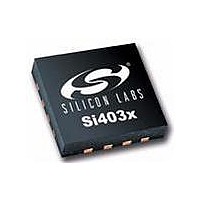SI4031-B1-FM Silicon Laboratories Inc, SI4031-B1-FM Datasheet - Page 30

SI4031-B1-FM
Manufacturer Part Number
SI4031-B1-FM
Description
IC TX 240-930MHZ -8-13DB 20VQFN
Manufacturer
Silicon Laboratories Inc
Type
ISM Transmitterr
Datasheet
1.SI4031-B1-FMR.pdf
(58 pages)
Specifications of SI4031-B1-FM
Package / Case
20-VQFN
Frequency
240MHz ~ 930MHz
Applications
General Purpose
Modulation Or Protocol
FSK, GFSK, OOK
Data Rate - Maximum
256 kbps
Power - Output
13dBm
Current - Transmitting
30mA
Data Interface
PCB, Surface Mount
Antenna Connector
PCB, Surface Mount
Voltage - Supply
1.8 V ~ 3.6 V
Operating Temperature
-40°C ~ 85°C
Operating Frequency
240 MHz to 930 MHz
Maximum Operating Temperature
+ 85 C
Mounting Style
SMD/SMT
Operating Supply Voltage
1.8 V to 3.6 V
Supply Current
30 mA
Lead Free Status / RoHS Status
Lead free / RoHS Compliant
Features
-
Memory Size
-
Lead Free Status / Rohs Status
Lead free / RoHS Compliant
Available stocks
Company
Part Number
Manufacturer
Quantity
Price
Part Number:
SI4031-B1-FM
Manufacturer:
SILICON LABS/芯科
Quantity:
20 000
Company:
Part Number:
SI4031-B1-FMR
Manufacturer:
INFINEON
Quantity:
12 000
Si4030/31/32-B1
4.2.2.3. Direct Mode using SPI or nIRQ Pins
In certain applications it may be desirable to minimize the connections to the microcontroller or to preserve the
GPIOs for other uses. For these cases it is possible to use the SPI pins and nIRQ as the modulation clock and
data. The SDO pin can be configured to be the data clock by programming trclk = 10. If the nSEL pin is LOW then
the function of the pin will be SPI data output. If the pin is high and trclk[1:0] is 10 then during TX mode the data
clock will be available on the SDO pin. If trclk[1:0] is set to 11 and no interrupts are enabled in registers 05 or 06h,
then the nIRQ pin can also be used as the TX data clock.
The SDI pin can be configured to be the data source in TX mode if dtmod[1:0] = 01. In a similar fashion, if nSEL is
LOW the pin will function as SPI data-in. If nSEL is HIGH then in TX mode it will be the data to be modulated and
transmitted. Figure 9 demonstrates using SDI and SDO as the TX data and clock:
If the SDO pin is not used for data clock then it may be programmed to be the interrupt function (nIRQ) by
programming Reg 0Eh bit 3.
4.2.3. PN9 Mode
In this mode the TX Data is generated internally using a pseudorandom (PN9 sequence) bit generator. The primary
purpose of this mode is for use as a test mode to observe the modulated spectrum without having to provide data.
30
nSEL
SDO
SDI
SPI output
SPI input
don’t care
don’t care
Figure 9. Microcontroller Connections
SPI output
command
SPI input
TX on
MOD input
Data CLK
TX mode
Output
Rev 1.1
SPI output
command
SPI input
TX off
don’t care
don’t care
SPI output
command
SPI input
TX on
MOD output
Data CLK
Output
TX mode
SPI output
command
SPI input
TX off












